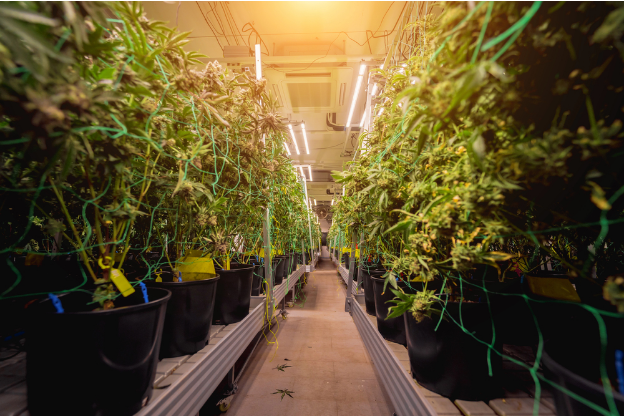Germinating cannabis seeds is the first and most crucial step in growing healthy marijuana plants. Without proper germination, seeds won’t sprout, leaving you with a failed crop before the process even begins.
Understanding the right conditions—temperature, moisture, and oxygen—is key to maximizing germination rates.
This guide covers everything from selecting viable seeds to the best germination methods and troubleshooting common problems. So, whether you’re a beginner or an experienced grower, these techniques will help you start your cannabis plants the right way.
Understanding Cannabis Seed Germination
Germination is the process of awakening a dormant cannabis seed and triggering its growth into a seedling. When a seed is exposed to moisture, warmth, and oxygen, it begins to sprout. The seed shell cracks open, and a small root (taproot) emerges, followed by the first tiny leaves known as cotyledons.
This stage is critical because it determines the strength and vitality of your plant. Weak germination can lead to stunted growth or failure to develop.
How Long Does It Take for Weed Seeds to Germinate?
Cannabis seeds typically sprout within 24 hours to 7 days, depending on the method used and the seed’s age and quality. Fresh, high-quality seeds germinate faster than older, dried-out ones.
Factors that affect germination time include:
- Temperature: Ideal range is 70–85°F (21–29°C).
- Moisture: Seeds need to stay damp but not soaked.
- Oxygen: Proper airflow prevents mold and promotes healthy growth.
- Seed age: Older seeds may take longer or fail to sprout.
How to Tell If a Cannabis Seed Is Viable
Before growing weed seeds, inspect your seeds to ensure they are healthy. Good seeds are:
- Dark brown or gray (light or green seeds may be immature).
- Firm to the touch (avoid soft, squishy seeds).
- Slightly striped (not always, but a common trait of viable seeds).
A simple way to check viability is the float test: Drop seeds in a glass of water. If they sink within a few hours, they’re likely good. If they float for over 24 hours, they may be dead.
Best Germination Methods for Weed Seeds
Paper Towel Method (Most Popular & Beginner-Friendly)
This is the most widely used method due to its simplicity and effectiveness.
How to Germinate Using the Paper Towel Method:
- Gather Materials: Paper towels, two plates, purified water, and cannabis seeds.
- Moisten the Paper Towels: Dampen (but don’t soak) a paper towel with water.
- Place the Seeds: Spread the seeds evenly between two damp paper towels.
- Cover and Store: Place the paper towels between two plates to maintain darkness and moisture.
- Check Daily: Look for sprouting taproots (usually in 24–72 hours).
- Transplant When Ready: Once the taproot is ½ inch long, move the seed to soil or another medium.
Pros: High success rate, easy to monitor growth.
Cons: Roots can stick to the paper towel, requiring careful handling.
Direct Soil Germination (Natural & Low-Stress Method)
Some growers prefer planting seeds directly in soil to avoid transplant shock.
How to Germinate in Soil:
- Choose the Right Soil: Use light, well-draining soil with no added nutrients.
- Plant the Seed: Dig a small hole (¼–½ inch deep) and place the seed inside.
- Cover and Water Lightly: Gently cover with soil and mist with water.
- Keep Warm: Maintain a temperature of 70–85°F.
- Monitor Growth: In 3–7 days, the seedling should emerge.
Pros: Less handling, reduces risk of damaging taproots.
Cons: Harder to monitor progress, lower germination rate for older seeds.
Water Glass Method (Best for Older Seeds)
Soaking seeds in water helps rehydrate them, especially if they’re older or slow to sprout.
How to Germinate Using the Water Glass Method:
- Fill a Glass with Water: Use room-temperature, purified water.
- Drop the Seeds In: Let them soak for 12–24 hours in a dark, warm place.
- Wait for Sinking: If seeds sink, they are absorbing water and are viable.
- Transfer to Soil or Paper Towels: If taproots emerge, carefully move the seed to its growing medium.
Pros: Great for stubborn seeds, speeds up hydration.
Cons: Can drown seeds if left too long.
Rockwool or Peat Pellet Method (Best for Hydroponics)
Ideal for hydroponic growers or those wanting a controlled environment.
How to Germinate in Rockwool or Peat Pellets:
- Soak the Growing Medium: Rockwool or peat pellets must be pre-soaked in pH-balanced water.
- Insert the Seed: Place the seed in the hole in the pellet or cube.
- Keep Warm and Humid: Store in a propagation tray with a humidity dome.
- Wait for Sprouting: In 2–7 days, seedlings should emerge.
Pros: No soil needed, great for hydroponic systems.
Cons: Can retain too much moisture, risking mold growth.
Optimal Conditions for Germination Success
Maintaining the right temperature and humidity levels is crucial for successful germination. The ideal temperature range is between 70–85°F (21–29°C), while humidity should be kept at 70–90% to provide the necessary moisture for seed activation.
If natural conditions are not ideal, using a heat mat or a humidity dome can help regulate the environment and promote consistent sprouting.
Light is not required until the seeds have successfully sprouted. Once they emerge, they should be placed under weak grow lights to encourage healthy seedling development.
Proper watering and moisture control are also essential. The growing medium should remain moist but not overly soaked, as excess water can suffocate the seeds and cause rot.
Transplanting Germinated Seeds
Transplanting germinated seeds should be done when the taproot reaches about ½ to 1 inch in length. At this stage, they can be moved into soil, hydroponics, or another growing medium.
To prevent transplant shock, handle the seed carefully using tweezers or clean hands. Avoid touching the delicate taproot, and bury the seed just below the surface with the taproot facing downward.
Common Germination Problems and Solutions
Several common issues can arise during cannabis germination. If seeds fail to sprout, it may be due to old age, incorrect temperature, or improper moisture levels. In such cases, the water glass method or light scarification can improve germination rates.
Mold or rot is another frequent problem, typically caused by excessive moisture or poor airflow. Keeping seeds in a clean, well-ventilated area can prevent this issue.
In some cases, seeds may sprout but fail to survive, often due to damping-off, dehydration, or poor transplanting techniques. To avoid this, maintain stable growing conditions and avoid overwatering seedlings.
The Takeaway
Germinating weed seeds successfully requires the right balance of moisture, warmth, and oxygen. The paper towel method is the most popular, but direct soil germination and the water glass method also work well.
By monitoring conditions and handling seedlings carefully, growers can maximize success rates and set the foundation for a healthy cannabis crop.
Now that you know how to germinate weed seeds, it’s time to put these methods to the test and start growing strong, thriving plants.


